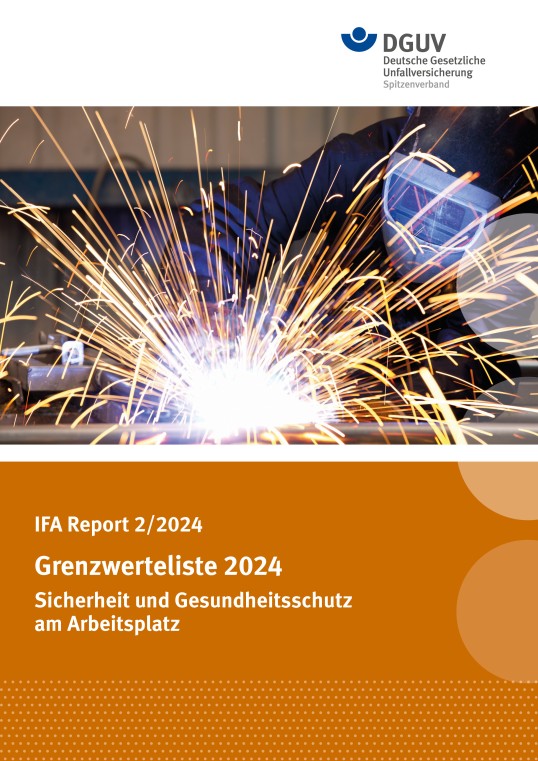- Artificial Intelligence (AI)
- Occupational exposure limit values
- Climate Change and Occupational Safety
- List of CMR substances
- Electromagnetic fields
- Ergonomics
- Industrial Security
- Collaborative robots
- Noise
- Nanoparticles at the workplace
- Optische Strahlung
- REACH
- Reference materials
- Proficiency testing
- Vibration
- Virtual reality
- Work 4.0
Occupational exposure limit values (OELs)

Grenzwerteliste (IFA Report 2/2024)
Occupational exposure limit values are an important tool for the protection of employees from risks to their health and safety due to hazardous substances. According to Art. 2, Sec. 8 of the German Hazardous Substances Ordinance (GefStoffV), the occupational exposure limits (Arbeitsplatzgrenzwerte - AGW) state the concentration of a substance below which acute or chronic harmful effects on health are not generally expected. OELs are thus based exclusively on available occupational medical experience and toxicological findings.
OELs (AGW) for chemical substances in workplace air are derived or evaluated by the Committee on Hazardous Substances (Hazardous Substances Commission, Ausschuss für Gefahrstoffe - AGS) according to the criteria of the BekGS 901 "Kriterien zur Ableitung von Arbeitsplatzgrenzwerten" (GMBl. 2010, No. 32, p. 691) and published in the TRGS 900. The AGS evaluates OEL proposals from the following sources:
- The MAK values of the DFG Commission for the Investigation of Health Hazards of Chemical Compounds in the Work Area (DFG: German Research Foundation)
- The indicative OELs of the European Commission
- International limit values (e.g. from the Netherlands)
The Federal Ministry of Labour and Social Affairs in Germany is publishing the OELs from 2007 onwards in the Joint Ministerial Gazette (Gemeinsames Ministerialblatt) and in the Federal Gazette (Bundesanzeiger). Information on OELs is contained in the following:
- GESTIS database - International limit values for chemical agents
- GESTIS substance database with facts and figures on hazardous substances
- Gefahrstoffliste (Hazardous Substances List) online (in German)
- Grenzwerteliste (Limit Value List) online (in German)
- TRGS 900 (in German)
- European Commission Criteria documents for Occupational Exposure Limits.
- DFG Commission Criteria documents for MAK values
Occupational exposure limit values for carcinogenic substances
In accordance with the German Ordinance on hazardous substances (GefStoffV), the employer must ensure that the workplace exposure limits are complied with at work. However, a workplace exposure limit cannot currently be derived for the vast majority of carcinogenic substances. For this reason, the Committee on Hazardous Substances (AGS) established an overall concept for setting risk-based limit values for carcinogenic substances (TRGS 910). The risk-based values are based upon a working lifetime of 40 years and continuous exposure every working day. The concept is closely related to a concept of graduated measures for minimizing risk in the workplace.
Substance-specific concentration figures derived from well-founded exposure-risk models are compiled in TRGS 910 and should be taken into account by the employers during their risk assessment.
Further links
- Guide for the quantification of cancer risk figures after exposure to carcinogenic hazardous substances for establishing limit values at the workplace